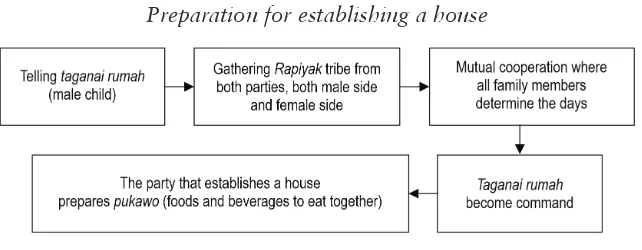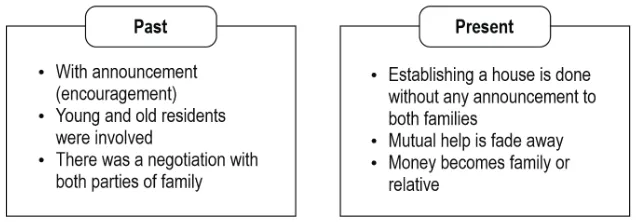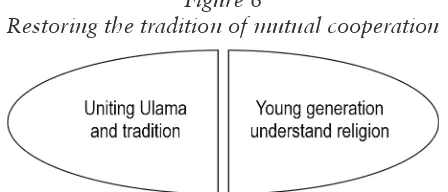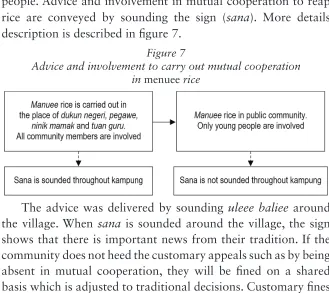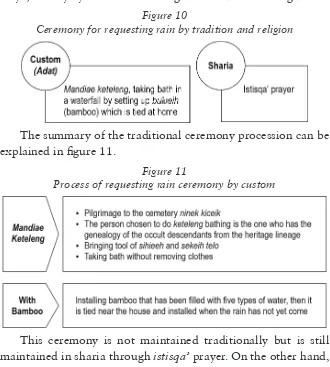Vol. 26 No.2 (2018) pp 417-444
DOI: http://dx.doi.org/10.21580/ws.26.2.2753
CULTIVATING LOCAL WISDOM IN CHARACTER EDUCATION: LESSONS FROM FAMILY EDUCATION VALUES OF INDONESIAN
TRADITIONAL CEREMONY
T E S T I A N I M A K M U R1* , W E N N Y DA S T I N A2 1Universitas Islam Negeri Sunan Kalijaga Yogyakarta 2Universitas Islam Negeri Sulthan Thaha Saifuddin Jambi
Abstract
The tradition of establishing a house in Tanjung Pauh, Kerinci contains noble educational values such as deliberation, mutual co-operation, togetherness, knowing and helping each other, mono-theism, recalling kindness, and courtesy. Those values are aligned with the concept of character education proposed by Thomas Lickona. The values can be implemented into family education es-pecially in rural communities of Tanjung Pauh, Kerinci. The char-acter values in harvesting rice carried out by the community teach civilized attitude towards plants and sharing with others. Besides, the community also has principles of respect, attention, respect, and compliance with customs regulations. The ceremony is per-formed based on custom and religious teachings with the intention to reject any disasters experienced by human beings, plants, and animals. Besides, the ceremony performed contains meanings of gratitude to God Almighty in order to reduce the punishment of the grave space, especially for parents who died and owned rice
fields. For those who are still alive, these activities are carried out
with the hope that everything done runs well, gains healthy bodies and longevity.
Tradisi membangun rumah di desa Tanjung Pauh, Kerinci men-gandung nilai-nilai luhur pendidikan bagi generasi selan-jutnya seperti musyawarah, gotong royong, kebersamaan, saling men-genal, tolong menolong, tauhid, mengenang kebaikan, dan adab. Nilai-nilai tersebut selaras dengan konsep pendidikan karakter yang diutarakan oleh Thomas Lickona. Nilai-nilai tersebut dapat implementasikan kedalam pendidikan keluarga masyarakat Ker-inci khususnya di desa Tanjung Pauh, KerKer-inci. Nilai karakter dari kegiatan menuai padi yang dilakukan oleh masyarakat yaitu adab bersikap terhadap tumbuh-tumbuhan dan berbagi dengan yang lain. Selain itu, masyarakat tersebut juga memiliki prinsip-prin-sip penghar-gaan, perhatian, penghormatan dan kepatuhan pada peraturan adat. Masyarakat juga menyelenggarakan upacara tolak bala yang dilakukan secara adat dan ajaran agama yang memiliki makna untuk menolak segala jenis bencana baik yang dialami ma-nusia, tumbuhan maupun binatang. Disamping itu, upacara tolak bala yang dilakukan juga mengandung makna rasa syukur atau ucapan terima kasih kepada Tuhan yang maha kuasa agar diberi-kan kelapangan azab kubur khususnya kepada orang tua yang su-dah meninggal dunia dan mempu-nyai sawah. Adapun bagi mere-ka yang masih hidup, kegiatan tersebut dilakumere-kan dengan harapan mendapatkan kelancaran atas apa yang dikerjakan, kesehatan ser-ta panjang umur.
Keywords: character education; cupak gantang; family education; local wisdom; traditional ceremony.
Introduction
without education, and it will always be in the scope of culture (Hasanah 2012). The relationship between education and culture is inseparable and interconnected (Tilaar 2004). Therefore, the blend of education and culture leads to character education. It should be applied in a variety of social order, formal and non-formal education. One of the non-non-formal educational settings is a family environment. Koesoema suggests that an effective and intact character education includes three basic designs. One of them is a community-based character education design. In this design, components outside educational institutions, such as a family, have a moral responsibility to integrate the formation of character in the context of life. This design is reinforced by Phillips’ statement saying that character education should involve all parties; home and family; school; and wider school environment or society (2010).
originality and uniqueness without any influence or mixture of elements from other areas.
The values applied by particular groups of people reflects the sustainability of local wisdom. Community groups hold hereditary values firmly. In Kerinci community, the noble values can be found in a traditional ceremony Cupak Gantang Kerja Kerapat maintained by the entire regions including Tanjung Pauh Kerinci village. The traditional ceremony of Cupak Gantang Kerja Kerapat has a sense that a traditional ceremony related to livelihood and social life of the community must be done through working together such as building a new house, harvesting rice, ceremonies rejecting reinforcements, and requesting for rain. The tradition has the meaning and function of goodness and nobility. In the transformation process of delivering moral value messages, shared values strengthen the relationship and emotion for the establishment of a forum for communication between young and old; form a concern for others; embody the attitude of helping each other; and familiarize cooperation as a means of fostering life norms. Everything is a feature of the character and identity.
many young people are not familiar with and runs local wisdom traditions. It is caused by a family education that begins to leave the local traditions and does not apply identity strengthening the family as an element of local knowledge (2013). Kartadinata reinforces this argument in Alwasilah (2009) which states that many people who are dazzled by the Western education system are blind to the benefits of the local culture long buried in the earth of Indonesia. Likewise, Ruyadi explains that the source of character values is derived from the cultural environment of the school, families, and communities (Ruyadi 2010). Therefore, the local identity has noble values that need to be cultivated and invested in family education.
environment to values cultivation (Sumaryadi 2012). Therefore, the local wisdom values should be embedded and explored in family education continuously in order to be used as the basis of family education implementation. This is in line with Asrianti’s argument stating that Indonesian people should return to their identity through reinterpretation and reconstruction of noble cultural values (Asriati 2013). For that purpose, the values are inculcated within the frame of character education
Character education relates to cultures, ethics, and morals. The Indonesian Dictionary defines characters as psychological traits, morality, or character that distinguishes someone from other people. Popular Scientific Dictionary defines character as disposition or habit. The definitions are reinforced by Suyanto’s description that mentions nine pillars of character derived from universal noble values, namely God’s love character and all of His creations; independence and responsibility; honesty, trustworthiness and diplomatic; respect and courtesy;being generous; being helpful and mutual cooperation;confidence and hard work; leadership and justice; kind and humble; tolerance, peace and unity (Suyanto 2010). These values are in line with Lickona’s concept that character contains three essential elements, namely knowing the good, loving the good, and doing the good (Lickona 2009). Kirschenbaum furthermore says that character education has a close relationship with components of knowledge of moral tradition, moral reasoning, compassion and altruism, and moral inclination (Kirschenbaum 1995).
education, civic education and character development (Latif 2009). However, character education should not leave and apart from the local wisdom that exist in a society.
Local wisdom refers to traditional and unique knowledge developed by people at specific conditions in some geographical regions (Larasati 2012). The characteristics of local wisdom are based on experience; tested after centuries; adapted to current culture; combined in the daily practices of people and institutions; commonly carried out by individuals or society as a whole; characterized dynamic and continuously changing, and related highly to the belief system (Kirschenbaum 1995). All forms of local wisdom are lived out, practiced, taught and passed down from generation to generation to shape human behavior pattern toward other human beings, nature, and supernatural things (Keraf 2010). A number of experts classify local wisdom into five categories namely wisdom in the form of philosophy; wisdom in the form of social life attitudes, and advice revealed in the form of proverbs, parables, poetry or folklore; wisdom in the form of traditional ceremonies; wisdom in the form of principles, norms, and rules that are tangible into social system; wisdom in the form of habits and daily behavior in social interaction (Rasyidin, Siregar, and Batubara 2009). Therefore, it imperative to investigate how those forms of local wisdom were practiced and implemented by a community. One of the communities that practiced them was Kerinci community.
the religion of Heavens (Islam). From the rituals of traditional ceremonies, it is clearly illustrated how the relationship between humans and supernatural powers is beyond the human power that influences their lives. Therefore, the people of Alam Kerinci have many ceremonies and traditional arts in each indigenous region or country depending on the ico used in each neghoi (village).
This study is aimed at revealing some problems as follows: (1) How can local wisdom-based character education in Kerinci family education be viewed from the tradition of establishing of a new house? (2) How can local wisdom-based character education in the family education of Kerinci community be seen from the tradition of mutual harvesting? (3) How can local wisdom-based character education in the family education of Kerinci community be viewed from the tradition of rejecting reinforcement and disaster, and requesting rain ceremonies?
Local Wisdom-Based Character Education in the Family Edu-cation of Kerinci Community in the Tradition of Establishing a New House
The tradition of mutual cooperation to establish houses in Tanjung Pauh began since the existence of life in that village because there were still few people at that time. One village had only a few families, so other family members should be called and invited to establish houses because they could not do it themselves. Then the negotiations were carried out to carry out mutual cooperation (kinerjaosamo) to establish houses (umah). The mutual cooperation tradition began to disappear in Tanjung Pauh because of the increasing population composition. The loss of the tradition is illustrated in figure 1.
Figure 1
The beginning of the loss of mutual cooperation (gotong royong) tradition in establishing houses
The process of establishing a house in the age of ancestors in Tanjung Pauh was illustrated in the figure 2.
Figure 2
Preparation for establishing a house
arah (asking/giving directions) has a relation with depati ninik mamak2. The process of establishing houses in Tanjung Pauh must go through a series of stages which start from panggan or inviting depati ninik mamak and asking for ajun arah to ninik mamak. This stage means that the party, who builds the slaughter house, occupies or respects ninik mamak. The next stage is process of asking for direction is carried out by giving uang arah. After ajun arah is carried out, there is no more extended responsibility of ninik mamak, and the family wholly owns the responsibility. Ninik mamak’s direction to protect border is aimed that there is no land dispute in Tanjung Pauh and always obey the rules. If the land that will be used to establish a house has not been completed or is still in dispute, ninik mamak will not give direction. Meanwhile, the types of assistance brought by public and Due Rupiyak tribe when building houses are shown in figure 3.
Figure 3
Types of assistance when establishing houses
The tradition of mutual cooperation to establish houses in Tanjung Pauh has mok nyo salah purpose i.e., to be agreed, simultaneous, and merged. Thus, the tradition of building a house contains values to educate the next generation. These values are useful not only to strengthen unity and kinship but also to increase harmony in the life of society in general. Also, the tradition also serves as a vehicle for establishing a sense of
2 Depatininik mamak is the chieftain,the highest symbol in the Kerinci
togetherness; a forum for communication between the older and the younger generation; and a means of fostering traditional values that are timeless. In general, the tradition also contains values such as (1) the principle of deliberation, by prioritizing deliberation for consensus, (2) mutual cooperation to unite and blend into one feeling, (3) togetherness, with the principle of Brotherhood between those who establish a new house with Rapiyak tribe, the community, and depati ninik mamak, (4) the principle of mutual understanding by recognizing the maternal lineage of the parents to the ancestors so they can find out who their ancestors, the grandparents, and the siblings of parents are, (5) principles of responsibility, where the responsibility of the male child or teganai rumah become a mutual assistance command while establishing the house. Depati ninik mamak has a responsibility in giving directions so that land boundaries do not become dispute in the future. At the same, the responsibility ensures that there is no other people land is used. Such principle teaches people not to take rights of others and maintain togetherness, (6) the principle of help is based on selfless sincerity without asking for compensation, and (7) the principle of not to take the rights of others.
Figure 4
The difference between past and present mutual cooperation in establishing houses
Some parties take part in mutual cooperation in establishing houses in Tanjung Pauh, Kerinci. Those parties are Rapiyak tribe, taganai (male child), depati ninik mamak, and the community. The parties involved have different roles as explained in table 1.
Table 1
The roles of those are involved in mutual cooperation in establishing houses
Rapiyak tribe Helping to invite people, cook, and provide material and physical.
Taganai (male child) Becoming heap to know which one is light or weight. Depati ninik mamak Giving ajun arah
Community Helping physically and take sekauh.
parties and the community. Whereas when they establish a house they sprinkle the sarigin3on the pillar of the house while reciting certain sentences. Sarigin and the expression are as illustrated in figure 5.
Figure 5
The content of sarigin and sentences expressed
The reason for expressing the sentence is because they believe that every land has its occupants and each tree has its contents. This is a form of belief in other beings. It is in line with the Islamic concept of believing in qaḍa and qadar. Before sarigin is released in the house area, prayers and ṣalawat are read as rejecting reinforcements to be safe. Prayers are also given to lighten the torment of the grave of the person who owned the land of both parties. This is with the aim to remember the services of parents who had cut the wood by hand. All of this is done because the land used by the community to build a house in Tanjung Pauh in Kerinci was formerly a jungle. The differences and similarities in mutual cooperation tradition in establishing houses in Tanjung Pauh, Kerinci are as illustrated in table 2.
3 A traditional herb that is used in the indigenous events of Kerinci, in
Table 2
Differences and similarities of the mutual cooperation tradition in establishing houses
Difference Similarity
- Changes in population composition
- Changes in house model
- Taganai roles
- Menu served
- Ajun arah, money direction and putong bereh sepuluh aya sikok
From the activities of establishing new houses, there several values of character education that can be conclude, for example (1) unifying the fraternity of all relatives of mother and father sides, either near or far; (2) Tawhid principle where each work is always preceded by prayer and ṣalawat so that what is done is safe; (3) The principle of recognizing or remembering goodness through gratitude, considering the services of previous parents, glorifying ancestral spirits because they have cut down wood and left land inheritance for posterity; and (4) Adab (courtesy) principle namely mutual respect and ethics among creatures of God, either those can be seen by the eyes or those cannot be seen by the eyes. Supporting the last value, Buya Hamka states that the inability of our eyes in seeing the other creatures does not mean that they do not exist. Instead, it is only caused by our eyes that cannot see them (Hamka 2015).
Those noble values should be implemented into family education in Kerinci community especially in Tanjung Pauh because they contain principles of monotheism, remembering goodness, adab, and brotherhood. These values are in line with the 2010 Ministry of National Education Curriculum which contains 18 values of character education such as religious, caring, respecting and many others. Therefore, character education in Indonesian context refers to noble values that originate from culture (Gunawan 2012).
people bustle, (2) diminished social sense, (3) diminished sense of brotherhood, (4) the society point of view, (5) the view that the old tradition is considered to be left behind , (7) individual attitudes, (8) selfish attitudes, and (9) the abandonment of traditional lessons. The step to restore the tradition of mutual cooperation in establishing new houses is to unite tradition with sharia.
Figure 6
Restoring the tradition of mutual cooperation
Uniting ulama and tradition are highly necessary because both parties cannot be separated in returning to old traditions. Meanwhile, religious and customary leaders seem to blame each other so far. When ulama and tradition are not united; the younger generation also does not understand religion; so returning to the old tradition will be difficult. On the other hand, cultural values and traditions must be maintained and inherited through three educational institutions, namely community, family, and traditional ceremonies (As’ari and Hendriawan 2016). The same thing is also stated by Sumaryadi arguing that the civilization process is found in three pillars, namely the pillars of family, school, and society (As’ari and Hendriawan 2016). Even traditional ceremonies are good social media and intermediary factors that become the basis of activities and social interactions in a community (Santoso 1984).
The tradition of reaping rice in Tanjung Pauh, Kerinci has become a tradition inherited for centuries. In the past, the tradition was called manuee, in which its early history was carried out to unite young people because there was an element of joy through mutual help. Gadieh (girl) sometimes helps bujang (boy), and vice versa, bujang sometimes helps gadieh. When carrying out mutual cooperation in manuee, both gadieh and bujang do ngaro or ‘unrequited rhymes’ that make them happy and enthusiastic to work (begawe).
When menuee is in the place of a teacher, a traditional healer, ninik mamak and pegawi, then an advice to the community to participate in mutual cooperation to harvest rice is announced. Menuee rice activities in general public involve only young people. Advice and involvement in mutual cooperation to reap rice are conveyed by sounding the sign (sana). More details description is described in figure 7.
Figure 7
Advice and involvement to carry out mutual cooperation in menuee rice
twenty-five rupiahs or the equivalent of wages of helping menueei in a day. Thus the values contained in special advice for mutual cooperation are the principles of respect, attention, respect, and compliance with the customary rules and leaders.
The reasons why the tradition of mutual cooperation to reap rice is not maintained are due to lack of social sense between the family and the community and selfishness or individualism so that the present generation does not understand tradition and sharia. This is in line with Koentjaraningrat’s concept that before money becomes an economical means, agricultural activities are carried out in mutual cooperation by the community. After the money is used, human labor that mutually works together is replaced by money and a rent system (Koentjaraningrat 2009). The step to restore the tradition is by uniting tradition and sharia. This step must be carried out because both tradition and religion are aimed to bring individual community members into social beings. As long as both parties do not unite, they will still blame each other. If not done, it will be difficult to restore the noble tradition that contains sacred and aesthetic values between humans, nature and other creatures. However, maintaining tradition or local wisdom as a medium for strengthening the identity of regions and filtering out values originating from outside are very crucial. As Ayatrohaedi states that the nature of local wisdom is the ability to control foreign cultures (Ayatrohaedi 1986).
Character Education-Based on Local Wisdom in Family Edu-cation of the Kerinci Community Viewed from the Tradition of Rejecting Reinforcement Ceremony
The tradition of rejecting reinforcements in Tanjung Pauh, Kerinci is held every year in the month of Ṣafar. It is carried out regularly when the rice menuee has finished. The origin
generation. The ceremony of rejecting reinforcement in Tanjung Pauh, Kerinci has the purpose of refusing to reinforcement and disposing of bad luck. The purpose could be described in figure 8. The community organizes the rejection of reinforcement ceremony based on tradition and sharia manner as described in figure 9.
Figure 8
The purposes of rejecting reinforcement ceremony
Figure 9
The ceremony of rejecting reinforcement based on custom (adat) and sharia
Based on these reasons, it will be difficult to restore the tradition of rejecting reinforcements by custom. It is necessary to unite between custom and ulama to sit together and discuss in order to find solutions to revive the noble traditions. By reviving the old tradition, the effort to maintain cultural existence has been carried out by introducing the philosophy and historical background contained in it and filtering the entry of foreign cultures. Sumaryadi (2012) argues that the main elements that must be preserved are natural, socio-cultural and economic. The main objectives of ensuring the sustainability and existence of local wisdom are that the previous, now, and future generations have equal rights and opportunities to enjoy the existing local wisdom. Currently, the rejecting reinforcement ceremony which is still be carried out is Hajat prayer. Through that prayer, people can convey various desires, including rejecting reinforcement. In addition, rejecting reinforcement is also carried out on Friday by reading qunūt prayer without any ṭawaf or surrounding the village.
Character Education-based on Local Wisdom in Family Educa-tion of Kerinci Community Viewed from the TradiEduca-tional Cere-mony of Requesting Rain
Pauh, Kerinci the ceremony to request rain is carried out in two ways, namely by tradition and religion as illustrated in figure 10.
Figure 10
Ceremony for requesting rain by tradition and religion
The summary of the traditional ceremony procession can be explained in figure 11.
Figure 11
Process of requesting rain ceremony by custom
considered not in accordance with religious teachings. In this case, local cultural values should be seen as a social inheritance and community dignity entity, not vice versa as something that is contrary to religion or not in accordance with the era.
Geertz believes that local wisdom is an entity that significantly determines human dignity and values in the community. Therefore, when traditional values that exist in the community are lost, the community will lose their identity and their sense of pride and ownership (Ernawi 2010). On the other hand, identity is a cultural character that functions as a character builder (Lubis 2008). Thus, the way to restore the ceremony for requesting rain by custom is by uniting tradition and religion, and not assuming that the tradition is misguided because it contains noble values. Custom and ulama should strengthen the noble values of local wisdom because they are the spearhead in maintaining tradition. This opinion is not much different from Christeward’s argument on cultural preservation which demands the institution’s active roles and village stakeholders to cooperate with the community in maintaining cultural values and local wisdom (Alus 2014). Therefore, the factor in reviving the noble tradition needs to involve custom, ulama and the community. Meanwhile, the noble values contained in the ceremony of requesting rain are a mutual need and religious principles.
components of the family. Such attitudes are needed in family education because, in the current globalization era, people are increasingly distant from noble values where they measure brotherhood with money, mutual help is wan and replaced by individualism, not knowing bloodlines, even religious education is put aside.
Conclusion
safe. Besides, the tradition also inculcated principles of knowing goodness, thanking with constant remembrance of parents’ services, glorifying ancestral spirits because they have been struggling to cut wood, leaving the land inheritance to posterity; and courtesy for mutual respect and ethics toward creatures of God.
The tradition of reaping rice in Tanjung Pauh Hilir, Kerinci, had become a tradition that has been carried out from generation to generation. Manuee’s early history was to unite young people in joy. The process of harvesting rice contains the values of courtesy toward plants and sharing. The values contained in the special advice for mutual cooperation in reaping rice are principles of respect, attention, respect, and community’s compliance with traditional regulations. The factor that caused tradition of mutual cooperation to reap rice had not been maintained was due to lack of social sense between family and society, selfishness and lack of understanding custom and sharia by the current generation. The way to restore this tradition is the union between custom and sharia. As long as custom and sharia were not united, efforts to restore the noble traditions that were full of sacred and aesthetic values between humans, nature and other creatures would be complicated to be realized. The union between custom and sharia was a way to save, expand and strengthen traditions so that they could function as religious and social.
whenever harvesting rice was finished, (2) at the end of Safar month (around Safar 27), and (3) every Monday, Tuesday, and Wednesday night. The ceremony involved depati ninik mamak, mosque officials, religious scholars, community figures, and community.
The ceremony of requesting rain was a ceremony made by begging God during the long dry season. The ceremony was held in two ways, namely custom and sharia (religion). The former was made by mandiae keteleng (bathing in a waterfall) and installing bulueih (bamboo) tied at home. The latter was made by istisqa’ prayer which was announced through the mosque and all people participated. Traditional ceremony by custom was no longer maintained but the one by sharia, istisqa’ prayer, is still being maintained. The ceremony by sharia even is not performed for ten years because the long dry season does not occur. The ceremony by custom is not performed anymore because it is considered a heretical, different understanding of religious teaching, and assumptions that are not in accordance with the religious beliefs. In general, the values contained in this ceremony are the mutual need and religious principles.
Bibliography
Alus, Christeward. 2014. “Peran Lembaga Adat dalam Pelestari-an KearifPelestari-an Lokal Suku Sahu di Desa BalisoPelestari-an KecamatPelestari-an
Sahu Kabupaten Halmahera Barat.” Acta Diurna 3 (4):
1–16.
Alwasilah, A. Chaedar, K. Suryadi, and Tri Karyono. 2009.
Et-nopedagogi: Landasan Praktek Pendidikan dan
Pendi-dikan Guru. Bandung: Kiblat Buku Utama.
Pengurangan Risiko Bencana Terkait Perubahan Iklim, 472–86. Surakarta: Muhammadiyah University Press. http://publikasiilmiah.ums.ac.id/handle/11617/8546.
Asriati, Nuraini. 2013. “Mengembangkan Karakter Peserta Di-dik Berbasis Kearifan Lokal Melalui Pembelajaran di
Se-kolah.” Jurnal Pendidikan Sosiologi dan Humaniora 3 (2):
106–19.
Ayatrohaedi. 1986. Kepribadian Budaya Bangsa: (Local
Ge-nius). Jakarta: Dunia Pustaka Jaya.
Ernawi, Imam S. 2010. “Harmonisasi Kearifan Lokal Dalam
Regulasi Penataan Ruang.” In Harmonisasi Penataan
Ru-ang Dan Budaya Untuk Mengoptimalkan Potensi Kota.
Yogyakarta: Universitas Gadjah Mada.
Fajarini, Ulfah. 2014. “Peranan Kearifan Lokal dalam
Pendi-dikan Karakter.” Sosio-Didaktika: Social Science
Edu-cation Journal 1 (2): 123–30. https://doi.org/10.15408/
sd.v1i2.1225.
Gunawan, Heri. 2012. Pendidikan Karakter: Konsep dan
Imple-mentasi. Bandung: Alfabeta.
Hamka. 2015. Falsafah Hidup: Memecahkan Rahasia
Ke-hidupan Berdasarkan Tuntunan Al-Qur’an dan
As-Sun-nah. Mutiara Falsafah Buya Hamka. Jakarta: Republika.
Hasanah, Aan. 2012. “Pengembangan Pendidikan Karakter Ber-basis Kearifan Lokal pada Masyarakat Minoritas: Studi atas Kearifan Lokal Masyarakat Adat Suku Baduy
Bant-en.” Analisis : Jurnal Studi Keislaman 12 (1): 209–28.
https://doi.org/10.42042/analisis.v12i1.637.
Keraf, A. Sonny. 2010. Etika Lingkungan Hidup. Jakarta:
Pen-erbit Buku Kompas.
Kirschenbaum, Howard. 1995. 100 Ways To Enhance Values
Koentjaraningrat. 2009. Sejarah Teori Antropologi. Depok: Pen-erbit Universitas Indonesia.
Larasati, Purwahyuningtyas. 2012. “Pelestarian Manuskrip Ber-dasarkan Kearifan Lokal Di KHP Widya Budaya Keraton Yogyakarta.” Skripsi, Depok: Universitas Indonesia.
Latif, Yudi. 2009. Menyemai Karakter Bangsa: Budaya
Keban-gkitan Berbasis Kesastraan. Jakarta: Penerbit Buku
Kom-pas.
Lickona, Thomas. 2009. Educating for Character: How Our
Schools Can Teach Respect and Responsibility. New York:
Bantam Books.
Lubis, Zulkifli. 2008. “Potensi Budaya dan Kearifan Lokal Se
-bagai Modal Dasar Membangun Jati Diri Bangsa.” Jurnal
Ilmu-Ilmu Sosial 9 (3): 339–46.
Magdalia, Alfian. 2013. “Potensi Kearifan Lokal Dalam Pem
-bentukan Jati Diri Dan Karakter Bangsa.” In Proceedings
of the 59th Ethnicity and Globalization, 424–35.
Yogya-karta.
Maryani, Enok, and Ahmad Yani. 2016. “Kearifan Lokal Mas-yarakat Sunda dalam Memitigasi Bencana dan
Aplikasin-ya Sebagai Sumber Pembelajaran IPS Berbasis Nilai.”
Jur-nal Penelitian Pendidikan 14 (2): 114–25.
Mulyadi, Agus. 2011. “SBY: Pendidikan Karakter Sangat
Pent-ing.” Kompas, May 2, 2011. https://nasional.kompas.com/
read/2011/05/20/21473385/SBY.Pendidikan.Karakter. Sangat.Penting.
Niode, Alim S. 2007. Gorontalo: Perubahan Nilai-nilai Budaya
dan Pranata Sosial. Jakarta: Pustaka Indonesia Press. Phillips, C. T. 2010. “Family as the School of Love.” In National
Character Building: Opportunities and Challenges.
Jakar-ta: Universitas Negeri Jakarta.
Pen-didikan Karakter Anak.” Republika Online, February 15, 2012. https://republika.co.id/berita/gaya-hidup/parent- ing/12/02/15/lzfbhg-lingkungan-keluarga-pengaruhi-pen-didikan-karakter-anak.
Priyatna, Muhammad. 2017. “Pendidikan Karakter Berbasis
Kearifan Lokal.” Edukasi Islami: Jurnal Pendidikan Islam
5 (10): 1311–36. https://doi.org/10.30868/ei.v5i10.6. Rahimin Affandi Abd. Rahim, Ruzman Md Noor, Anuar Mohd
Ramli, and Nor Hayati Md Dahlal. 2012. “Pemodenan dan Kesejahteraan Manusia dari Perspektif Orientalisme.” Jebat: Malaysian Journal of History, Politics and Strategic
Studies 39 (December): 1–23.
Rasyidin, Al, Parluhutan Siregar, and Khuzaimah Batubara. 2009. “Penyerapan Nilai-Nilai Budaya Lokal dalam Ke-hidupan Beragama di Medan: Studi Tentang Budaya Lokal
di Medan” in Afif dan Bahri, Saeful.” Harmonisasi Agama
dan Budaya di Indonesia. Jakarta: Balitbang Kemenag.
Ruyadi, Yadi. 2010. “Model Pendidikan Karakter Berbasis Kear-ifan Budaya Lokal: Penelitian terhadap Masyarakat Adat Kampung Benda Kerep, Cirebon, Provinsi Jawa Barat untuk Pengembangan Pendidikan Karakter di Sekolah.”
In Proceedings of The 4th International Conference on
Teacher Education, 577–595. Bandung: Universitas
Pendi-dikan Indonesia & Universiti PendiPendi-dikan Sultan Idris. Santoso, Budi. 1984. “Upacara Tradisional Kedudukan dan
Fungsinya dalam Masyarakat.” Majalah Analisis
Kebu-dayaan, 1984.
Sumaryadi. 2012. “Kearifan Lokal Mesti Dilestarikan!” Yogya-karta: Universitas Negeri Yogyakarta
Suyanto. 2010. “Urgensi Pendidikan Karakter.” Babadan: Waski-ta Mandiri
Tilaar, Henry Alexis Rudolf. 2004. Paradigma Baru Pendidikan
Warsidi, Edi. 2017. “Mewujudkan Penguatan Peran
Kel-uarga dalam Pendidikan Anak.” Tempo Media
Group, March 1, 2017. https://indonesiana.tempo.co/
